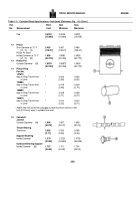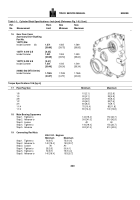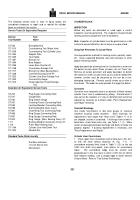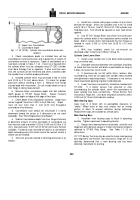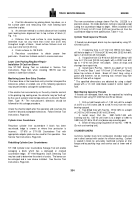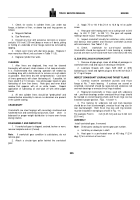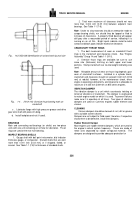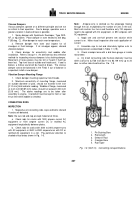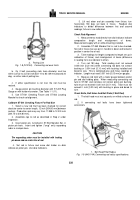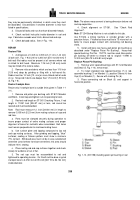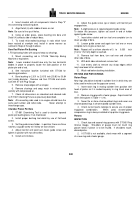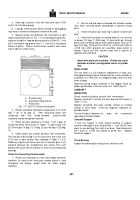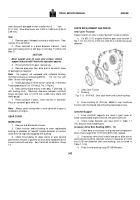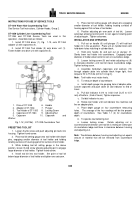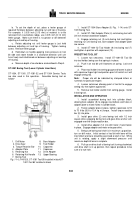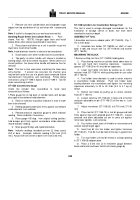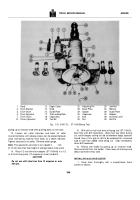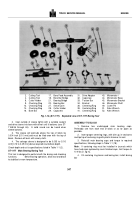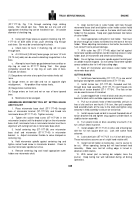TM-5-3805-254-14-P-2 - Page 343 of 894
TRUCK SERVICE MANUAL
ENGINE
they may be permanently stretched, in which case they must
be discarded.
Discard bolts if smallest diameter is less than
listed in specifications.
3.
Discard all bolts and nuts that have distorted threads.
4.
Check rod bolt hole pilot inside diameter in rod and
cap.
If diameter exceeds wear limits, discard rod and cap.
5.
Check bolt pad radius.
See (1-Fig.
1-9).
REPAIR
Restore Fillet
1.
A dimension of 0.045 to 0.055 inch [1.14 to 1.40 mm]
(2 bolt rod 1, Fig.
1-9)(0.240 to 0.260 inch [6.10 to 6.60 mm] 4
bolt rod) fillet radius must be present at all corners where rod
is milled for bolt head.
Maximum 1/16 inch [1.59 mm] metal
may be milled off to restore radius.
2.
Remove nicks and dents which are less than 1/16 inch
[1.59 mm] deep by grinding or filing with a half-round file.
Radius must be 1/2 inch [12. mm] or more, Blend radii at ends
of cut.
Scrap rod if dents are deeper than 1/16 inch [1.59 mm]
(3, Fig. 1-6).
Resize Crankpin Bore
Resize only if crankpin bore is outside limits given in Table 1-1
(11).
1.
Remove old piston pin bushing with ST-870 Mandrel
and Block.
Install cap and tighten nuts to operating tension.
2.
Recheck rod length on ST-561 Checking Fixture, If rod
length is 11.991 Inch [304.57 mm] or less, rod cannot be
resized and must be discarded.
Note:
Rod must measure 12. inch [304.80 mm] in length to
remove 0.009 inch [0.23 mm] from mating surfaces of cap and
rod face.
a.
Parts must be clamped securely during operation to
insure proper contact of entire mating surfaces and proper
alignment of bores for rod bolts when assembled.
Bolt holes
must remain perpendicular to machined mating faces.
b.
Use surface plate and lapping compound to lap rod
and cap mating surfaces.
After grinding and lapping, "blue"
surfaces; seating or flatness pattern must show a minimum
75% contact.
Still-blued area must not be in area outside bolt
centerline (area farthest from bore centerline); this area should
indicate 100% seating.
c.
Place mating rod and cap surfaces together and check
closely for evidence of out of flat.
3.
The rod cap must be reassembled to rod and
tightened to operating tension.
On 2 bolt rod line bore or grind
crankpin bore to 3.2720 to 3.2725 inch [83.119 to 83.134 mm]
inside diameter.
Note
: The above measurement is boring dimension before rod
and cap separation.
4.
Check alignment on ST-561.
See "Check Rod
Alignment".
Note
: ST-294 Boring Machine is not suitable for this job.
Use ST-526, a milling machine or cylinder grinder with a
precision fixture. Finished surface must be to 75 micro-inch or
better to insure proper contact with connecting rod bearing
shells.
5.
Install and bore new heavy-wall piston pin bushing as
described under "Replace Piston Pin Bushing".
Heavy-wall
special bushing, Part No.
1’52770, must be used, Bore piston
pin bushing off-center to restore rod to original 11.998 to
12.000 inch [304.75 to 304.80 mm] length.
Replace Piston Pin Bushing
1.
Remove worn tapered bushings with ST-1242 Mandrel
and Detail (5, Fig. 1-10), remove tool.
2.
To install standard size tapered bushing (7) in rod,
assemble bushing (7) on Mandrel (1), position Sleeve (4) then
Cup (2) on Mandrel (1).
Secure with Locking Pin (6).
3.
Place connecting rod on Block (3) and support in
horizontal position.
Fig. 1-10. (N10158) Installing piston pin bushing in rod.
339
Back to Top

